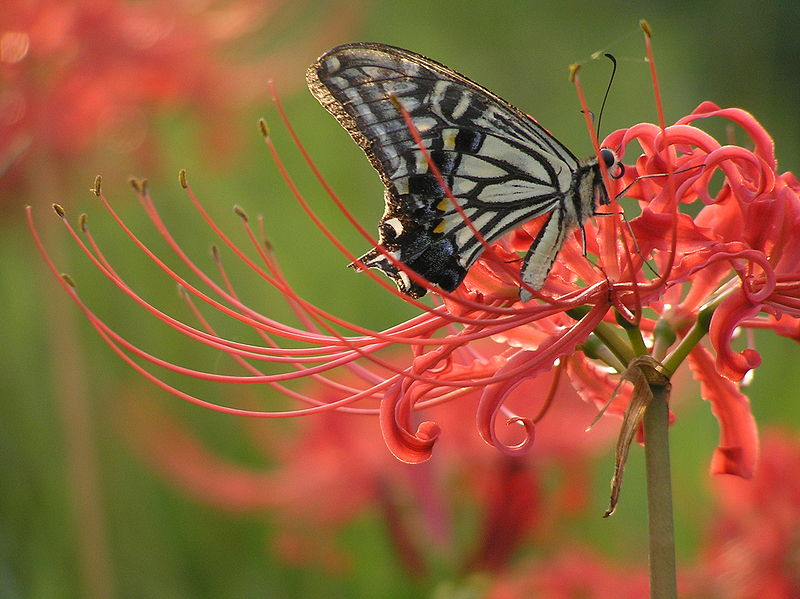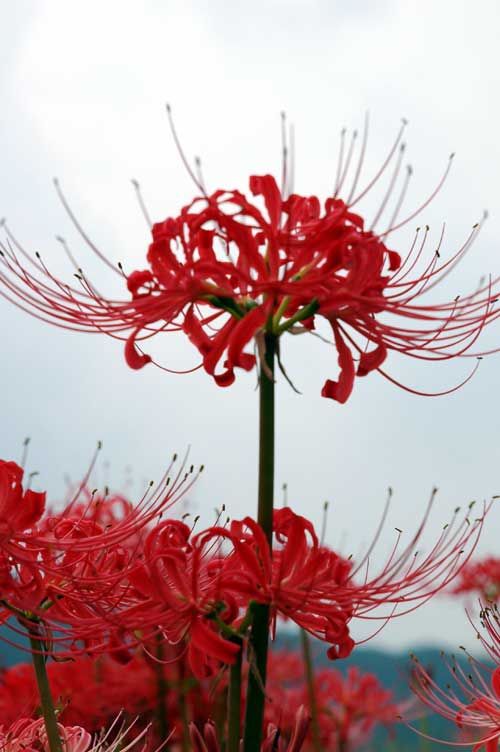王菲 《彼岸花》 (Flower of Paradise) 曼珠沙华的故事
A song by Faye Wong, biggest Asian pop singer.
- Title: 彼岸花
- Date: 2000
- Singer: 王菲
- Lyrics: 林夕
- Music: 王菲, 張亞東
看見的,熄滅了。 消失的,記住了。 我站在,海角天涯。 聽見,土壤萌芽。 等待,昙花再開。 把芬芳,留給年華。 彼岸,沒有燈塔。 我依然,張望著。 天黑,刷白了頭髮。 緊握著,我火把。 他來,我對自己說。 我不害怕,我很愛他。
What was seen, went out like a flame. What has disappeared, will be remembered. I stand, at the corner of the sea, the edge of the sky. I hear, sprouting from the ground. Waiting, for the Queen of the Night to bloom. Saving such fragrance, for the best to come. On the opposite shore, there is no light. But I still yearn. Night, bleached my hair. I grasp the torch tightly. He comes, I say to myself. I am not afraid I love him dearly.
English translation by Kevin Wei (Aezura)
昙花, Queen of the Night
Note: 昙花 is “queen of the night”. “Queen of the Night” is a night-blooming cactus. See: Night-blooming cereus . The technical term of 昙花 in English is Epiphyllum, aka orchid cacti, one of the night blooming cactus. It bears large, strongly fragrant flowers. It bloom for a single night only.

曇 tán = 昙
彼岸花, Red Spider Lily

The title of the song is 彼岸花. Literally, it means “flower of the other shore”. What flower is that? It is red spider lily. (Lycoris radiata, 石蒜)
Lycoris radiata (red spider lily) is a plant in the amaryllis family, Amaryllidaceae.
Originally from China, it was introduced into Japan and from there to the United States and elsewhere. It flowers in the late summer or autumn, often in response to heavy rainfall. The common name hurricane lily refers to this characteristic, as do other common names, such as resurrection lily.
It can not reproduce sexually. The plant has both sexes and when they produce they just randomly assort their chromosomes so that there is no order to the assignment to each plant. Since there is no order in the chromosomes assortment that means the plant is sterile. The only way for the plant to reproduce is by bulb division.
[from Wikipedia Lycoris radiata]
The Red Spider Lily does not like heat. It prefers a warm environment. When the summer heat becomes unbearable for the Spider lily it becomes dormant. It will then return when the weather has become cooler. They are originally from China. …
The bulbs of Lycoris radiata are very poisonous. These are mostly used in Japan, and they are used to surround their paddies and houses to keep the pest and mice away. That is why most of them grow close to rivers now. In Japan the Red Spider Lily signals the arrival of fall.
传说: 曼珠沙华,血红色的彼岸花。一般认为是生长在三途河边的接引之花。花香传说有魔力,能唤起死者生前的记忆。一般来讲,只有血的颜色才衬得起曼珠沙华,因此,我们一般所说的曼珠沙华指的是红花石蒜。
石蒜(学名:Lycoris radiata),又名红花石蒜、龙爪花、山乌毒,俗称蟑螂花、老鸦蒜,雅名曼珠沙华(源於梵語Mañjusaka)、彼岸花、莉可莉絲等,多年生草本植物,原产中国长江流域。目前广泛分布于东亚各地。种加词radiata意为“放射状的”。
The Story of Mañju (曼珠) and Saka (沙華)
Red Spider Lily has a sad legend.
When the flowers of lycoris bloom, the leaves would have fallen; when their leaves grow, the flowers would have wilted. The leaves and flower never appear at the same time.
Legend has it that the flower and leaves are two elves: Mañju (曼珠), who guarded the flower, and Saka (沙華), who guarded the leaves.
Out of curiosity, they defied their fate of guarding the herb alone, and managed to meet each other. At first sight, they fell in love with each other. Amaterasu, exasperated by their waywardness, separated the miserable couple, and laid a curse on them as a punishment: the flowers of Mañju shall never meet the leaves of Saka again. It was said that when the couple met after death in Diyu, they vowed to meet each other after reincarnation. However, neither of them could keep their words. In commemoration of the couple, some call the herbs ‘Mañjusaka’ (曼珠沙華), a mixture of ‘Mañju’ and ‘Saka’, instead of their scientific name.
佛经中的曼珠沙华
佛说此经已,结跏趺坐,入于无量义处三昧,身心不动。是时乱坠天花,有四花,天雨曼陀罗华,摩诃曼陀罗华,曼珠沙华,摩诃曼殊沙华。而散佛上及诸大众。 ----《法华经·卷一》 又云:
——云何曼陀罗华? ——白圆华,同如风茄花。 ——云何曼殊沙华? ——赤团华。 ----《妙法莲华经决疑》曼珠沙华、曼陀罗华,是佛经中描绘的天界之花。曼殊沙华、摩诃曼殊沙华、曼陀罗华、摩诃曼陀罗华、芬陀利华、摩诃芬陀利华等等这些称谓源于梵文佛经,曾于《大乘妙法莲华经》中记载过。摩诃的意思是大,大乘梵语发音即为摩诃衍那,至于衍那就是乘载的意思,华在古汉语中即是花之意。这些词语出现在古梵文佛经中,意指地上之花。

Christian Hell, Buddism Hell, Greek Underworld
In English, the title of the song is “Flower of Paradise”. The Chinese song name 彼岸花 literally means “the flower of the other shore”. Thematically, it should be “flower of the other side” or “flower of hell”. But “hell” gives the wrong impression. The “hell” here is buddism's mythology of hell. It shares with Christian's hell of after-life, judgement, but doesn't have a primary sense of “evil”. It's not associated “devil”, nor bearing a strong opposite of “paradise”. The Buddism's hell here is more in sync with Greek mythology's Underworld. Note that Buddism originates from India, which is closer to Greece. I wonder to what degree Greek mythology and Buddhism mythology are connected. (research TODO!)

Here's some user compiled info from Source zhidao.baidu.com
传说中的引魂之花,冥界唯一的花——彼岸花(绝美) 曼珠沙华,又称彼岸花。 一般认为是生长在三途河边的接引之花。 花香传说有魔力,能唤起死者生前的记忆。
春分前后三天叫春彼岸, 秋分前后三天叫秋彼岸。 是上坟的日子。彼岸花开在秋彼岸期间, 非常准时,所以才叫彼岸花。
彼岸花,花开开彼岸,花开时看不到叶子, 有叶子时看不到花,花叶两不相见,生生相错。 相传此花只开于黄泉,是黄泉路上唯一的风景。
彼岸花是开在黄泉之路的花朵, 在那儿大批大批的开着这花, 远远看上去就像是血所铺成的地毯, 又因其红的似火而被喻为“火照之路” 也是这长长黄泉路上唯一的风景与色彩. 人就踏着这花的指引通向幽冥之狱。
彼岸花,又名曼珠沙华,又称为 Red Spider Lily。 它生长的地方大多在田间小道,河边步道和墓地,所以别名也叫做死人花。 一到秋天,就绽放出妖异浓艳得近于红黑色的花朵,整片的彼岸花看上去 便是触目惊心的赤红,如火,如血,如荼。
彼岸花属于石蒜科(Lycoris Herb),属名是希腊神话中女海神的名字。 因为石蒜类的特性是先抽出花葶(总梗)开花,花末期或花谢后出叶; 还有另一些种类是先抽叶,在叶枯以后抽葶开花,所以才有“彼岸花,开彼岸, 只见花,不见叶”的说法。
曼珠沙华的美,是妖异、灾难、死亡与分离的不祥之美。或者是因为它深艳 鲜红的色泽让人联想到血,也或者是因为它的鳞茎含有剧毒,在一般的文学作品中, 它的形象通常是与“疯狂、血腥”之类的概念相联系起来的。在炎之蜃气楼的邂逅篇 《真皓き残响》中,桑原水菜笔下写到景虎自杀的瞬间,看到喷出的鲜血如同盛放 成群的彼岸花。
彼岸花开 花开彼岸时 只一团火红 花开无叶 叶生无花 相念相惜却不得相见 独自彼岸路 那一夜 梦中相会 你是白色无根莲 我是红色彼岸花 你苍白如雪 我妖红似血 你落落于天山镜池水沄沄 我寞寞在幽冥黄泉路漫漫 那一刻 爱上你 命里劫数 无路可逃 无所可逃 我会一直等 三千日斗转星移 你终于老去 我依旧沦陷 你来到渡口 前方暗河黑水潺湲 投以我浅浅一笑 孟婆汤碗已空 你踏上奈何桥 心静如水 心沉如石 我合上乱花枝 心痛破碎 心死无望 我脉脉花香的缠绵 抵不过苦涩寡汤的忘却 我还活着 没有灵魂只有肉体 却坚持爱你
